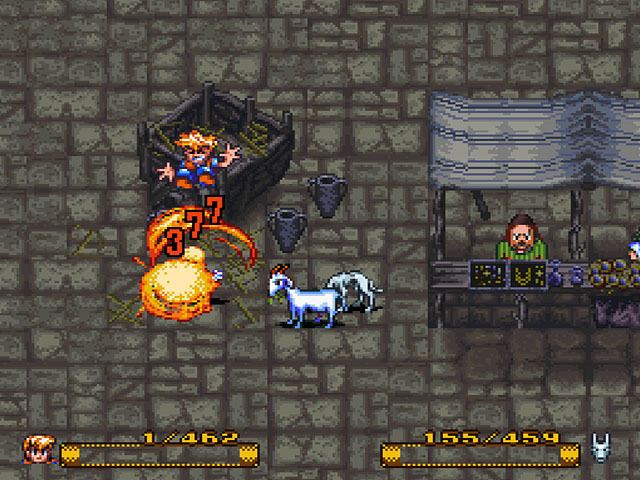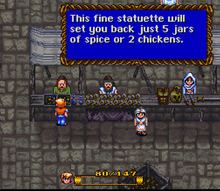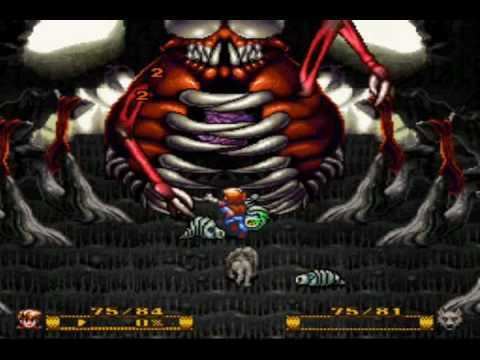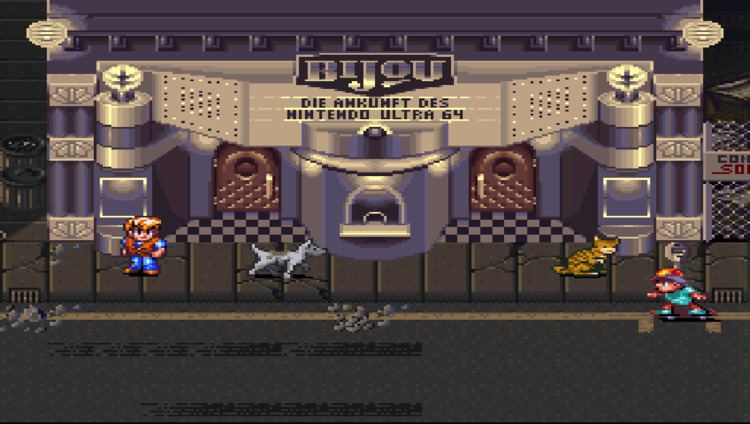9.6 /10 1 Votes
4.7/5 eBay Designer Doug Smith | 4.8/5 Emuparadise Initial release date 1 October 1995 Developer Square | |||||||||||||||||||||||||||||||||
Artist(s) Daniel DociuBeau Folsom Writer(s) George SinfieldPaul Mazurek Similar Square games, Action role-playing games | ||||||||||||||||||||||||||||||||||
Secret of evermore video walkthrough 1 2
Secret of Evermore is an action role-playing game for the Super Nintendo Entertainment System. It was released by Square in North America on October 1, 1995. In February 1996, it saw release in the PAL territories of Europe and Australia. A Japanese release was planned to follow the North American release by a few months, but was ultimately cancelled.
Contents
- Secret of evermore video walkthrough 1 2
- Secret of evermore snes review
- Gameplay
- Alchemy
- Setting
- Story
- Development
- Music
- Reception
- References

The story of Secret of Evermore follows a boy and his pet dog as they are inadvertently transported to a fantasy world created by an eccentric inventor. The player guides both the boy and his shapeshifting dog through Evermore, a world that is composed of separate realms, each resembling a different period of real-world history. The gameplay shares many similarities with Secret of Mana, such as real-time battles, a ring-shaped menu system, and the ability to switch control between the two characters. Despite similar game mechanics and a similar title, it is not an entry in the Mana series.

Secret of Evermore is unique in that it is the only game developed by Square designers in North America. The game received positive reviews upon its release due to its graphics and gameplay, but was criticized for not being up to the expectations many reviewers had of its developer.

Secret of evermore snes review
Gameplay

Secret of Evermore takes many of its interface and gameplay aspects from Secret of Mana. The game mostly consists of an aerial view setting, in which the boy and his dog negotiate the terrain and fend off hostile creatures. If the boy is currently selected as the player character, his dog will be controlled by the artificial intelligence, and vice versa. Both characters can find refuge in caves or a town, where they can regain their hit points or purchase restorative items and equipment. Upon collecting enough experience points in battle, either character can increase in level with improved stats such as strength and evasion. Options including changing equipment, casting alchemy spells, or checking status can be quickly performed by rotating through the game's Action Ring system. Combat takes place in real-time. Located below the players hit points is a percentage gauge that determines the amount of damage done to an enemy, as well as how far the player can run. Swinging a weapon or running causes the gauge to fall to 0% and then quickly recharges, allowing the character to attack at full strength or to run at full sprint once it is full. The gauge may also fill up to allowing the player to use charged attacks with equipped weapons.

The protagonist wields four different styles of weapons throughout the game: sword, spear, axe, and bazooka. Almost all swords, axes, and spears have four versions, and repeated use of them can increase their skill levels to a maximum of three, unlocking a new charged attack with each level. The range and power of each type of weapon increased the more it is used; for instance, spears at a high enough level may be thrown at an enemy across the screen, while the swords and axes can cut swathes of destruction around the boy's vicinity. With the exception of the Bone Crusher, all swords, axes, and spears can cut through vegetation; some weapons are required to break rocks and other barriers.

In each of the four worlds of Secret of Evermore, the in-game currency will change. The shopkeepers in Prehistoria exchange talons; in Antiqua, gemstones; in Gothica, gold coins; and in Omnitopia, credits. There are individuals in each region who offer to convert the player's money to the local currency. In either of the game's two marketplaces (located in Antiqua and Gothica, respectively), the storekeepers offer to trade in goods instead of money. Certain goods, such as rice, spices, and tapestries, can be bought using the local currency, but others must be exchanged for other goods. Most vendors only specialize in one type of good, and some rare items require an extensive amount of trading to obtain.
Alchemy
A unique element to Secret of Evermore is its system of magic. In order to cast magic, the boy must be given an "Alchemic Formula" by one of many non-playable characters called "Alchemists". Some Alchemists make their home in out-of-the-way areas and will dispense rare formulas if the player manages to seek them out. Unlike some role-playing games, there are no magic points needed to cast spells. Alchemy Formulas require pairs of ingredients in order to be used; Some are available throughout the game, and others are only native to certain environments. In the primitive realms, ingredients appear as such items as wax, limestone, clay, and gunpowder. In the advanced realms, however, the ingredients become more complex, such as ethanol and dry ice.
A secondary function of the dog is to "sniff out" ingredients by putting his nose to the ground and smelling for items. The player can command the dog to search the ground at any time, including in huts and cities. If all goes well, the dog will lead his human companion to a certain spot on the map, where the player can uncover the unseen ingredients. With repeated use, Alchemy Formulas will increase in level, enhancing their curative, offensive, or support effectiveness. Although there are dozens of Formulas available to be found within the game, only nine can be equipped at a time. To overcome this, there are several Alchemists scattered throughout the game who offer to manage the boy's current Alchemy list; any formula that has already been learned can be stored by the Alchemist for later use.
Setting
The plot revolves around a teenage boy and his dog, to whom the player must assign names. Most of the game takes place in the fictional world of Evermore. The player explores four main areas within this world, corresponding to different historical eras: Prehistoria contains cavemen and dinosaurs; Antiqua boasts a Colosseum and pyramid theme; Gothica contains medieval castles and is populated by dragons; and Omnitopia is a futuristic space station.
Throughout their travels, the boy, at the company of his dog, often quotes or mentions fictional B movies that relate to their current situation. For example, he compares himself to "Dandy" Don Carlisle in the film Sink, Boat, Sink after washing ashore at Crustacia. (For legal reasons, all references to movies and actors were fictional.) In addition, the dog's body transforms based on the theme of the area that players are in. In the world of Prehistoria, the dog is transformed into a feral wolf, in the Antiqua region he becomes a greyhound, in Gothica he takes the form of a fancy poodle, and in Omnitopia he becomes a robotic toaster-dog capable of shooting lasers.
Story
The story of Secret of Evermore begins with a black and white flashback to 1965, in a small town called Podunk, USA. In a laboratory situated on the roof of a mansion, a malfunction occurs which floods the area with white flash of light. Thirty years later, the game's young protagonist is leaving a theater when his pet dog chases after a cat in the street. The boy hurriedly follows after him, eventually reaching a large, abandoned mansion. He discovers the hidden laboratory with a large machine built in the center. When the dog begins to chew on some wires, the pair find themselves transported to the surreal world of Evermore, beginning in the space station Omnitopia. A butler dressed in a white tuxedo greets the boy when he appears, only to lock him in a room with several attack robots. The boy manages to escape in a shuttle pod, where he finds his dog holed up in the cockpit.
The shuttle crash-lands in a dense jungle on top of a plateau. When the boy emerges, he finds a ferocious-looking beast has replaced his dog. He decides to perform a test to see if the wolf and his pet dog are one and the same; he tosses a stick for the wolf to fetch, only to receive a giant bone instead. The boy shrugs this off and assumes that it is the same dog.
In each of the four realms, the boy encounters a citizen of Podunk involved in the original experiment gone awry 30 years ago. Professor Sidney Ruffleberg and his three companions were transported to Evermore, but are unable to leave. The boy quickly learns that the regions are manifestations of those citizens' personal utopias. Each of the three companions act as the ruler of his or her world: Elizabeth, the Professor's niece, is the tribal chief of Prehistoria; Horace Highwater, curator of the Podunk Museum, oversees Antiqua; Camellia Bluegarden, a portly librarian, is the Queen of Gothica; and Professor Ruffleberg monitors everything from Omnitopia, with his android butler, Carltron, alongside him. Within Prehistoria, Antiqua, and Gothica, the boy and his canine companion aid Elizabeth, Horace, and Camellia in thwarting attempts by robotic clones of the Podunk citizens from ruling their respective areas.
The duo finally returns to Omnitopia and finds Ruffleberg, who explains everything. He and his butler Carltron once engaged in chess matches. Ruffleberg outfitted him with an intelligence chip to make him a more challenging opponent, but the upgrade backfired by making Carltron more malevolent. He sabotaged the transporter to Evermore and designed the hostile beasts roaming the game. With Ruffleberg's help, the boy and his canine companion break into Carltron's room. The area is guarded by android clones of the boy and his dog, along with a giant mecha version of Carltron. At the last moment, Ruffleberg appears and deactivates Carltron, who promptly freezes in place.
With Carltron's defeat, the monsters plaguing Evermore disappear, but the world itself grows unstable. The boy returns to each of the worlds to collect Ruffleberg's companions, taking them back to the real world. In doing so, Evermore's destruction is averted and it continues to exist without them. After the credits roll, a final scene shows Professor Ruffleberg returning Carltron to his old task of cleaning the lab. Carltron grins and rubs his hands together, implying that he is not as docile as the professor believes.
Development
Development on Secret of Evermore began in early 1994 at Square Soft, the Redmond, Washington office of the Japanese parent company Square. The concept of a boy traveling with his dog through a world based on cheesy B movies was dictated from overseas, whereupon Square Soft began work on the detailed storyline. This resulted in popular culture references and dialog that are distinctly American for a mainstream console RPG. The game's associate producer and writer, George Sinfield, decided that making such references would be familiar to American players. The working title for the game was "Vex and the Mezmers." Producer Alan Weiss originally had the concept of a group of magic users who "could tell dream stories and transport the listeners into the experience, virtually. During one of these storytelling sessions, Vex got trapped in one of these worlds and started to corrupt the dreams. The game was going to be about finding Vex and defeating him." But when George Sinfield asked the name be changed, the studio had a naming competition which resulted in Secret of Evermore.
Many of Secret of Evermore's elements were copied from Secret of Mana because they had been proven to be effective. The size of the game was an early issue. It was decided that the game would be single-player to preserve memory because it was originally planned to be only 12-megabits. However, the game would double to 24-megabits near the end of development. Various pieces of concept art were designed by Daniel Dociu. Using computer software, including SGI Indy II and Alias workstations, the game's artwork and design were mapped out by three animators, four background artists, and a 3D rendering artist. It was put together using the company's SAGE (Square's Amazing Graphical Editor) program, led by programmer Brian Fehdrau. Rather than having to hand off their work to the programmers, the artists and designers were able to test their ideas directly using the SAGE program. Using another company program, SIGIL (Square Interpreted Game Intelligence Language), Secret of Evermore was made into a final product. One of the worlds that was cut was called Romancia "where 'everything is all flowers and sweet stuff, excessively so.' It was pink and purple."
There is a persistent misconception that the game is, or was released in lieu of, a follow-up to Secret of Mana. Other Square titles such as Final Fantasy VI and Chrono Trigger were being localized simultaneously with the production of Secret of Evermore. Fehdrau explained in an interview that Secret of Evermore was not created in place of Seiken Densetsu 3 and that the team that developed Secret of Evermore was assembled from newly hired staff, and would otherwise never have been assembled. Several of the team members joined Humongous Entertainment, which spawned Cavedog Entertainment, while the rest of the team spread to other Seattle-area game studios like Electronic Arts, Boss Game Studios, Microsoft Game Studios, and Gas Powered Games, among others.
Secret of Evermore was released on October 1, 1995, in North America. In 1996, it was translated into German, French and Spanish for the non-English-speaking market in some PAL territories, including Australia and New Zealand. Some PAL versions were packaged in a large box and included a strategy guide.
Music
The score for Secret of Evermore was composed and produced by Jeremy Soule as his first video game project. While still in high school, Soule was a large fan of video games and he felt that the scores in most games "lacked drama and intensity." After completing high school, Soule created an experimental demo showcasing what he felt video game scores should sound like. Soule was hired by Square Soft after reviewing the demo and was promptly given the task to score Secret of Evermore. The score is described by Soule as a mix of ambient sounds and low-key music. The soundtrack was released on a CD containing 29 tracks, the first eight of which are arranged versions of the original sound. The disc was published by Square and was only initially available to those who pre-ordered Secret of Evermore.
Reception
Secret of Evermore received positive reviews from most media outlets. Most publications praised its graphics. For instance, RPGFan called the game a "wonderful visual experience," applauding its use of color, animation, and background. Zachary Lewis of RPGamer noted that the locales found in Secret of Evermore were detailed in a much more realistic way than other games of the genre. Scary Larry of GamePro, however, found the spell animations to be weak compared to those of other Square games, and said the bosses are large but strangely unimpressive. Another highlight for some critics was gameplay, particularly the unique alchemy system and aspects also found in Secret of Mana such as the ring menu. However, others found these mechanics needlessly hard to get used to.
Reviewers were more critical concerning the game's sound. Although the quality of the musical compositions was praised, both RPGFan and RPGamer found that there were too few adequately long tracks, with mediocre ambient sound effects to fill the dead time, and Scary Larry complained of the player character's dog "constantly" barking. Super Play and GamePro both found that the game was not up to the standards held by other Square games. Others argued that Secret of Evermore was a decent first attempt by the American team. Game Players anticipated another game from the same development team, and a critic for Next Generation said that while the game suffered from a number of amateur mistakes, "as a debut title for a new team of designers, it points to a rosy future".
